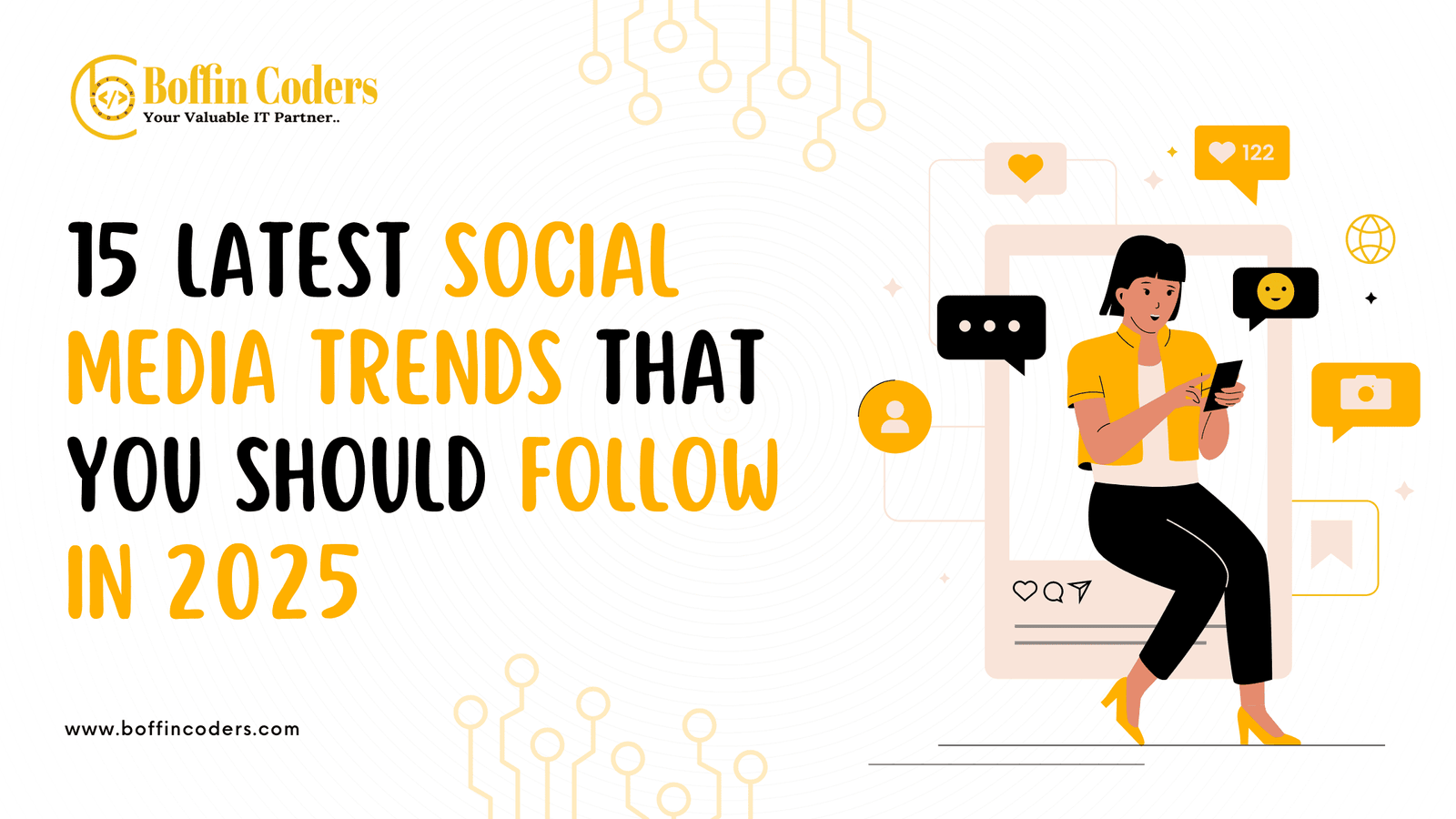Social media has ingested a deep notch in the lives of people within a very short period. What started off as a source to interact with friends and family soon became a channel for brands and businesses to connect with their target audience through well-crafted social media strategies.
Several trends in social media have emerged with the rapid growth of this medium and evolved over a period of time. It is actually adaptation to new and upcoming trends that helps the enterprise keep up with the fierce competition. In this blog, we will discover the 15 latest social media trends that you should follow in 2025.
- Short-Form Video Content: Short-form video content is becoming increasingly popular, with TikTok leading the way, followed by Instagram Reels and YouTube Shorts. People today prefer fast, attention-grabbing content that is easy to consume and highly shareable. Brands must focus on creating innovative, creative videos that convey their message in under a minute, as this trend is set to grow even more by 2025.
The strength of short-form video content lies in its ability to capture attention quickly. This format appeals especially to younger audiences, who tend to have shorter attention spans. With platforms constantly improving their video tools, brands have more opportunities to create visually engaging content that resonates personally with their audiences, ensuring they stay relevant in the fast-paced world of social media marketing. - AI-Driven Content Creation and Curation: AI-Driven Content Creation and Curation is revolutionizing how businesses and individuals produce and manage content. AI tools can now generate high-quality text, images, and videos in large quantities, saving time and making content more relevant and personalized. These systems analyze trends and user data to craft content that resonates with target audiences, making it a vital tool for marketers and creators.
AI-powered content curation selects and organizes content to meet specific audience needs. Algorithms filter through vast data to offer high-quality, relevant information to users based on their preferences and behavior. As AI advances, both content creation and curation will continue to evolve, allowing businesses to connect with their audiences in increasingly innovative ways. - The Rise of Social Commerce: Social commerce has rapidly become a significant trend in the digital space, allowing users to shop directly through platforms like Instagram, Facebook, and Pinterest. This makes it easy for brands to connect with customers in places where they already spend time. With features like product browsing, reviews, and seamless purchasing without leaving the app, social commerce improves user experience, shortens the buying journey, and boosts conversion rates.
By 2025, social commerce is expected to grow even more as brands increasingly adopt this feature. Influencers and user-generated content will continue to play a vital role in promoting products on these platforms. Businesses, big and small, will need to integrate social commerce into their strategies, offering in-app purchasing options and personalized shopping experiences to engage users. - Augmented Reality (AR) and Virtual Reality (VR): Augmented Reality (AR) and Virtual Reality (VR) are becoming essential tools for businesses to engage with customers. AR blends digital elements with the real world, allowing users to experience products virtually, while VR immerses users in fully digital environments. These technologies are especially transforming the retail, entertainment, and education sectors.
By 2025, AR will enable customers to try products virtually, such as clothes or furniture, and will enhance virtual tours. VR, on the other hand, will create immersive gaming experiences, virtual events, and training simulations. As these technologies become more accessible, brands will increasingly use them to offer innovative customer experiences. - Social Audio Platforms: Social audio platforms like Clubhouse and Twitter Spaces offer a new way for people to interact. Instead of posting text or images, users can engage in live audio conversations, which feel more personal and dynamic. These platforms are growing in popularity as people enjoy listening to or participating in real-time discussions on various topics.
Brands are also leveraging social audio to host live events, Q&A sessions, or product discussions. By 2025, social audio is expected to gain even more traction as it provides a unique, engaging way for audiences to connect. - Privacy and Data Security Concerns: As we approach 2025, privacy and data security are becoming more critical than ever on social media platforms. Users are becoming increasingly aware of how their personal data is collected and used, which has led to heightened concerns about data security. To maintain trust, brands will need to prioritize transparent policies about how they handle user data and offer clear ways for users to manage their privacy settings.
In 2025, it will be essential for companies to be transparent and proactive about securing their customers’ data. Businesses that demonstrate a strong commitment to protecting personal information will be more successful in building long-term relationships with their audiences. Data privacy will no longer be a backseat issue, but a core concern for users and brands alike. - Rise of Niche Social Networks: While mainstream platforms like Facebook and Instagram still dominate, there is a growing shift towards niche social networks in 2025. These smaller platforms cater to specific interests, hobbies, or professions, allowing users to connect in a more meaningful and focused way. These communities foster deeper engagement because they align closely with users’ passions and values.
Brands looking to connect with highly targeted audiences will need to focus on these niche networks. Instead of trying to reach everyone on large, general platforms, brands can benefit from engaging with smaller communities where their messages resonate more authentically. This rise of niche networks is expected to continue growing as people seek spaces tailored to their interests. - Rise of Niche Social Networks: While mainstream platforms like Facebook and Instagram still dominate, there is a growing shift towards niche social networks in 2025. These smaller platforms cater to specific interests, hobbies, or professions, allowing users to connect in a more meaningful and focused way. These communities foster deeper engagement because they align closely with users’ passions and values.
Brands looking to connect with highly targeted audiences will need to focus on these niche networks. Instead of trying to reach everyone on large, general platforms, brands can benefit from engaging with smaller communities where their messages resonate more authentically. This rise of niche networks is expected to continue growing as people seek spaces tailored to their interests. - Social Media for Customer Service: Social media is becoming a go-to platform for customer service in 2025. More and more users are turning to platforms like Twitter, Facebook, and Instagram to ask questions, report issues, and seek solutions. It allows companies to provide real-time responses and engage with customers directly, making service more immediate and accessible.
In 2025, businesses that integrate social media into their customer service strategy will have a significant advantage. Quick, efficient support via social media not only resolves issues faster but also strengthens the customer relationship. Customers will prefer brands that are available and responsive through the social channels they already use every day. - Influencer Marketing Evolution: Influencer marketing continues to be an essential part of brand strategies in 2025, but it’s evolving. There is now a shift toward micro and nano-influencers, who have smaller but highly engaged audiences. Unlike large-scale influencers, these smaller figures offer more authenticity and personal connections with their followers, making them ideal for specific niche campaigns.
As brands seek more genuine engagement, this evolution of influencer marketing will help them build trust with customers. In 2025, brands will need to carefully select influencers who align with their values and target audiences, focusing less on follower counts and more on genuine, impactful connections. - User-Generated Content (UGC): User-generated content remains a powerful tool in 2025. Brands are encouraging their customers to create and share content around their products, whether it’s through reviews, unboxing videos, or social media posts. UGC is highly effective because it reflects real customer experiences, making it more trustworthy and relatable than traditional advertising.
In 2025, brands that actively promote UGC will see higher engagement and increased trust from their audiences. Customers tend to rely on the opinions of other users before making decisions, so companies should make it easy for customers to share their experiences. This form of organic promotion will continue to be a key driver of brand credibility. - Gamification in Social Media: Gamification, the use of game-like elements in social media, is a rising trend in 2025. Platforms and brands are incorporating challenges, rewards, and interactive games into their content strategies to boost engagement. By turning user interactions into fun, competitive activities, brands can increase participation and hold users’ attention longer.
In 2025, we can expect more brands to use gamification to keep users engaged and build stronger connections with their audience. Whether it’s through badges, leaderboards, or interactive challenges, gamification taps into users’ desire for achievement and rewards, creating a more dynamic and enjoyable experience on social platforms. - Social Media for Business Networking: LinkedIn has paved the way for professional networking, but by 2025, more social media platforms will be integrating features for business networking. Professionals are using social media not just to connect socially but to form professional relationships, share expertise, and collaborate on projects. This trend offers brands an opportunity to network and find partners directly within social channels.
As we move further into 2025, businesses and professionals will increasingly turn to social media for career growth and opportunities. Building a strong presence on these networks will be crucial for both individual professionals and companies seeking to expand their reach in the business world. - Voice Search Integration: With the rise of voice assistants like Alexa and Siri, voice search is becoming an integral part of how users interact with social media in 2025. Users are beginning to rely on voice commands to search for content, brands, or products on social platforms. This shift towards voice search requires brands to optimize their social media content for voice queries.
In 2025, optimizing for voice search will be a key component of social media strategy. Brands will need to ensure their content is easily discoverable via voice commands, adapting to the way users are now consuming content. Voice search will continue to grow in importance, making it essential for brands to adapt. - AI-driven Customer Service: AI continues to shape customer service on social media, with chatbots and virtual assistants becoming more advanced in 2025. AI-driven solutions allow brands to respond to inquiries quickly and efficiently, offering round-the-clock support without human intervention. This not only improves customer satisfaction but also reduces operational costs.
In 2025, AI-driven customer service will be crucial for businesses that want to stay ahead. By automating simple tasks and providing immediate responses, AI enhances the customer experience and allows human teams to focus on more complex issues. AI-powered customer service will be a vital tool for brands to handle large volumes of customer interactions effectively.
These 15 trends will play a significant role in shaping how brands interact with customers on social media in 2025. Staying up-to-date with these trends will be crucial for businesses aiming to stay competitive and relevant in the evolving social media landscape.
Conclusion
In 2025, staying updated with the latest social media trends is crucial for businesses aiming to remain competitive. These trends, identified by social media experts, can help brands enhance their online presence and engage better with their audience. By adopting these strategies, companies can effectively navigate the ever-evolving digital landscape.
To fully capitalize on these trends, it’s essential to hire social media marketing experts who can guide your business toward success. Their expertise ensures that your social media campaigns are optimized, leading to increased brand visibility and customer engagement!




